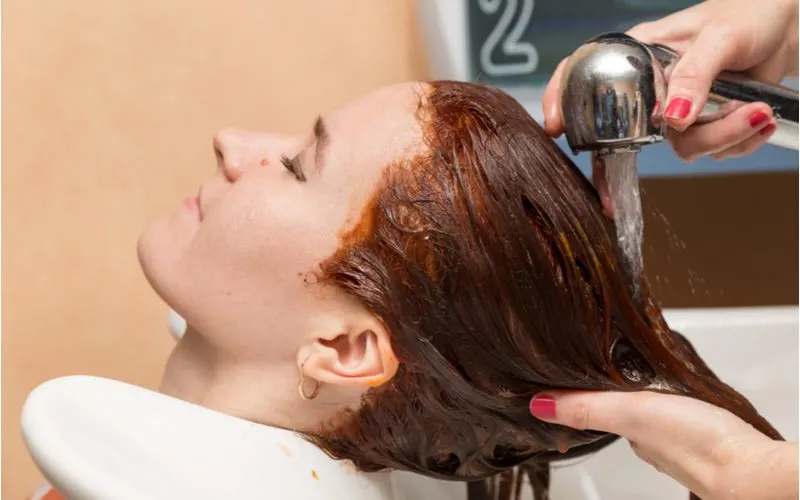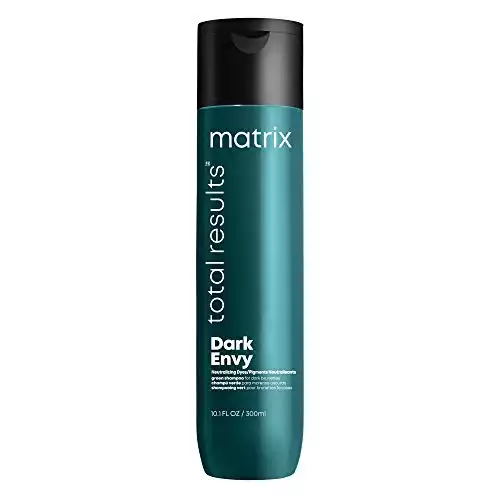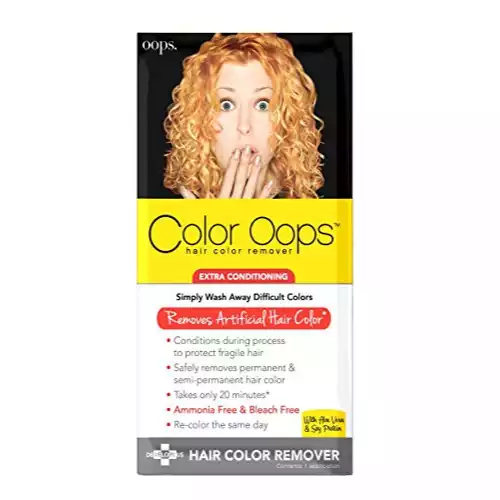Jump to:
Red hair color is a popular choice, but it’s challenging to remove, as it leaves behind brassy, orange tints that take a while to fade. Fortunately, we’ll show you how to get red out of your hair in five easy steps.
How to Get Red Out of Hair: A Summary
Red hair dyes and colors tend to be more challenging to remove, as they don’t fade entirely and often leave traces of gold, bronze, or orange behind. Removing red out of hair often requires a few easy steps, which involve a bleach kit or alternative hair color.
In a nutshell, these steps include:
- Allow your red hair color to fade naturally
- Use a green shampoo to tone down the red
- Try using a hair dye removal kit
- Use a darker dye to cover the shades of red
- Try ash tones or muted colors to subdue any red or brassy tones
- Lighten your hair
In short, you can opt to strip the red or tone it down with a few options or visit a salon to have the unwanted brassy, reddish hues removed or subdued professionally. Please note that we have ranked these solutions from easiest to hardest (on your stress level and on your hair). It’s always best to start with the simplest solution that will get the job done.
Read Next: How to Get Rid of Brassy Hair
How to Remove Red Hair Color in 6 Steps
There are several ways to remove red hair color, which can be an easy, almost effortless process or a method that involves several stages. It’s essential to decide which color or type of treatment you want to use to cover the red, such as a darker color or lightening your current shade to a pale blond or brown.
While red hair dye initially fades quicker than other colors, it’s more likely to leave a few traces behind in the form of highlights or tones against your original or dyed color. Generally, red hair often lasts longer than desired, which may require some extra steps in deleting it.
Read Next: Red Headed Hairstyles
Step 1: Allow Your Red Hair Color to Naturally Fade
If you use a temporary red hair dye or a rinse that only lasts a few weeks, the easiest option is to let it fade out on its own. If you used permanent red dye, it may take a bit longer to fade, but you can still give it a go. Just know you’re in for the long haul, especially if your hair was pre-lightened just before using the dye.
While growing out red hair dye can be a very long process, you can drastically cut your grow-out time if you’re wanting to try a new, shorter style. This can make a significant difference and reduce the impact of the red. So, don’t mess with the color until you get your new ‘do. Not only will you cause the least amount of damage to your hair, but you can also always revisit removing the red color if you still don’t like it even after getting your hair cut.
Semi-permanent and temporary tints tend to fade quickly and don’t require any additional treatment to remove the dye. Permanent dyes will remain on your hair strands, which can be grown out, or you can consider another treatment option.
Step 2: Purchase a Green Shampoo to Tone Down the Red
If your hair isn’t completely red, or if you just want to tame your red slightly, you may not have take drastic measures to tone down the red highlights or tints throughout your mane. Instead, you can incorporate a color-correcting shampoo into your haircare routine. For removing red tones, you will want to use a green pigmented shampoo.
How does green shampoo work? When you refer to the color wheel, you’ll notice that green is directly opposite red, which has a counter-effect on this shade. The color wheel identifies colors that contrast each other so that you can find an easier way to correct or reverse a specific color.
Since green is across the wheel from red, it targets undertones of red to neutralize them, so they don’t appear as vibrant. You can easily add a green shampoo or conditioner to your collection of hair care products for regular use, and within a few weeks, you’ll notice a significant difference.
If you have a green food coloring agent in your kitchen, you can easily add a few drops to your existing shampoo bottle, which also has the same effect of neutralizing red tones.
Step 3: Try Using a Hair Dye Removal Kit
Since red hair dye tends to be intense, it may stick for longer than it should be, especially for semi-permanent dyes. Red hues and shades tend to leave many pigments behind, even if a removal kit is used. So, use this method with caution. And, keep in mind, that color remover will only remove red dye that you deposited. If your hair has faded to red, color remover will only worsen your hair woes.
- Removes dye in 20 minutes
- Ammonia-free for less damage
- Formulated with aloe and protein
- Users dislike the scent
- Mixture is runny
Hair color removal offers to remove the dye in one step, though it’s essential to realize that the result will not restore your hair to its natural state. Hair color removal may leave your hair dry and discolored, unlike your natural hair color or the shade your hair was previous to the red.
Be prepared for this result and keep an extra box or tube of hair dye to use immediately after stripping the red color. For the most natural restoration, you may want to choose just one or two shades lighter or darker than your natural color.
Read Next: How to Lighten Dyed Hair
Step 4: Using a Darker Hair Dye to Cover the Shades of Red
Are you open to using darker hair colors to cover the intensity of red? Covering your current bright shade of copper or medium auburn can quickly tone down with a golden brown, or a deep chestnut shade can work those red highlights into a new color while toning the overall boldness of the red.
Shades of dark brown with bronze highlights and even black hues can significantly remove and tone down the red, while subtle undertones remain. This option is ideal if you want to keep a slight hint of red without overwhelming the overall color of your hair.
Step 5: Try Ash Tones or Muted Colors to Subdue any Red or Brassy Tones
Remember how we talked about using green shampoo to counteract red tones in the hair? You can do the same thing on a more permanent scale with semi-permanent and demi-permanent hair color. Choose a color with ash (green) or neutral undertones and mix it with 5- or 10-volume developer. When selecting your color, be sure to choose something that is the same level of lightness or darkness as your current color.
When used with low-volume developers, hair color acts as a toner. It doesn’t lift or deposit very much color, but it will change the tone of your hair. This is an easy way to get rid of unwanted red tones.
Step 6: Consider Lightening Your Hair
Hair bleach or lightener can offer a great way to remove any unwanted strands of red or bronze-like tones left behind from a previous dye. Lightening your hair is ideal if you’re dissatisfied with the outcome of a shade of blond or brown, especially if there are solid red tones that weren’t expected.
There are several options for lightening your hair: you can buy a kit with the developer and lightening cream ready to mix and apply or purchase these products separately.
If your hair is very dark, you’ll need a more substantial level of bleach to lift the color and remove the red. For lighter shades of red, such as light or medium auburn, copper, or strawberry blonde, a less intense lightener is sufficient.
Once you bleach your hair, you may want to leave it as is or add a new color immediately. It’s essential to follow the instructions of the bleach kit or products you choose to apply so that your hair isn’t too dried out or damaged.
Leaving bleach on your hair for too long can cause the strands to become brittle and break easily. Make sure you invest in a good quality conditioner and oil treatment to restore each strand.
Read Next: Should You Bleach Your Hair?
Things to Consider

Aleksei Lazukov/Shutterstock
- Muted ash tones are found in certain lines of hair color products. If you want to rid your hair of any traces of red soon after applying a dye, you can apply an ash tone to offset the results. You’ll find a lot of ash tones available at regular drug stores and beauty supply shops.
- If your hair is on the lighter side, choose an ash blond, and for darker tones, use an ash brown to tone down the red. The instructions are easy to follow on most store-bought hair dyes, and you’ll notice a difference soon after rinsing off the application to reveal less red.
- If you use a semi-permanent or temporary dye with unwanted red tones, you’ll also want to use a semi-permanent option for the ash brown or blond. Always choose a dye that’s the same level of permanence as the original product used. For example, if your initial hair dye was permanent, you’ll need to choose a permanent ash shade as well. Unless you just want to tone the color a bit. Then, it’s OK to use a less permanent solution.
- Good hair care is important to reducing the signs of damage after using hair dye removal. Depending on the intensity of the dye, more than one application may be required to remove or tone down the shades of red.
- Avoid washing your hair too often, and skip a shampoo, so that you’re not washing it every day. Every time you wash and shampoo, check the color to make sure it’s what you want and proceed with further treatment if needed.
- Clarifying shampoo is one of the best products for this purpose and generally contains between 80-90 % water. The product is also made of natural products, so no build-up of minerals or other materials can cause further damage.
So, How Do You Get Red Out of Your Hair?
Removing red dye or hues from your hair is an easy process, so if you’re uncertain which method to try, opt for the least intensive treatment. If the initial application doesn’t yield the desired results, be prepared to use conditioners or additional treatments to test other options.
Hair color removal can be a bit of a trial-and-error process at first, just as it may be challenging to choose the suitable dye.


